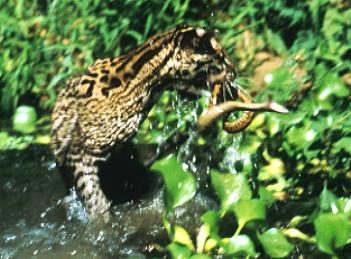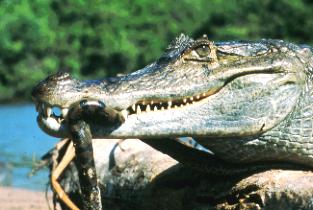The following copyrighted material is intended for individual use of the researcher, and may not be copied or distributed without written permission from the copyright holder. You may use it for non-profit scholarly purposes. The complete citation for this paper is Rivas, J. A., Owens R. Y. and P. P. Calle. 2001. Eunectes murinus: Juvenile predation. Herpetological Review. 32 (2): 107-108. Click here for a pdf
Eunectes murinus (green
anaconda): Juvenile predation. Larger
sized reptiles tend to suffer little predation but juveniles typically are more
exposed to mortality in their first years; this is the case in female green
anacondas (Rivas, J. A. 1999. Natural History of the green anaconda with
emphasis on its reproductive biology. Unpublished Ph. D. dissertation at the
On April 25 of 1995 we observed a female anaconda (187 cm TL and 3.25 Kg) being harassed by a crab-eating fox (Cerdocyon thous). The snake had been discovered while crawling on dry land, and had adopted a defensive position. The fox repeatedly tried to grab it, but jerked back each time as the snake snapped defensively. We interrupted the interaction and caught the snake, which had numerous ticks (evidence of having been on dry land for a while). If we had not interrupted the fox, the snake would probably have been eaten since she would have been exhausted in a short time and, not having any water nearby she was not likely to have escaped successfully.
On January 15 of 1996 we saw a tegu lizard (Tupinambis teguixin) carrying a neonate-size anaconda in its mouth, but we did not see the actual capture. The snake did not have any bite marks or external evidence of having been killed by the tegu, so it was not possible for us to assess whether the tegu killed it or had found it dead and was simply scavenging. However, since tegus are generalist foragers and often forage near the water they are likely predators of neonates.
We implanted transmitters in four neonate green anacondas to study habitat use on January 9, 1996. Two of them were found predated on February 12. We found one of the transmitters at the bottom of a tree that held an active nest of crested caracaras (Polyborus plancus; Falconidae). The other transmitter was found among some bushes with the antenna chewed up, but with no other hint regarding identity of the predator. The other two animals were alive at the end of the 3-month long follow-up but no information on their later survival is available. The animals reported in this contribution preying on juvenile anacondas are fairly common in the llanos. This suggests that risk of predation may be an important selection pressure leading to fast growth in juveniles.
Acknowledgement: We are in dept to The World Conservation Society and The National Geographic Society, and The Wildlife Conservation Society Field Veterinary Program for logistic support. We thank COVEGAN for allowing us to work on their land. We also thank W. Karesh, J. Thorbjarnarson, C. Molina, and M. Muñoz for help in the field work.
Jesús A. Rivas, RenÉe Y. Owens,
Venezuela Nature Tours, 17126 Jamul CA 91935, and Paul P. Calle, Wildlife
Conservation Society, Wildlife Conservation Park, 2300 Southern Blvd., Bronx,
NY 10460-1099
Some other examples of predation on Juveniles
follow (Photo Ed George).

